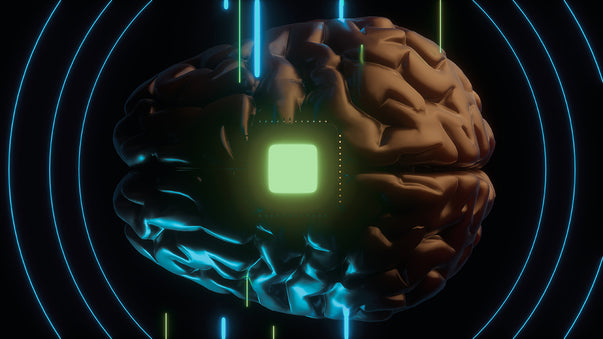The Fusion of Electronics and the Human Body

Scientists are taking steps toward integrating electronics with the body. Such devices could monitor for tumor development or stand in for damaged tissues. But “connecting electronics directly to human tissues in the body is a huge challenge,” notes a press release issued by the American Chemical Society (ACS). “Now, a team is reporting new coatings for components that could help them more easily fit into this environment.”
The scientists found that a polymer had the properties necessary for interfacing hardware and human tissue.The research results have been presented at the American Chemical Society (ACS) Fall 2020 Virtual Meeting & Expo. The scientists are “using flexible, organic electronics rather than rigid materials like silicon and covering them with bio-friendly coatings,” notes Futurism.
According to research leader David Martin, these biological-synthetic hybrid materials might someday be useful in merging artificial intelligence with the human brain.
Other related and intriguing advances have been presented at the ACS Fall 2020 Virtual Meeting & Expo. “Electronic devices and biological cells communicate through very different mechanisms,” notes another ACS press release. “Now, scientists report progress on tiny communication networks that overcome this language barrier, allowing electronics to eavesdrop on cells and alter their behavior - and vice versa.”
Nanoparticles Deliver Genetic therapy to Mice
Scientists led by Ohio State University have engineered lipid-based nanoparticles carrying two sets of protein-making instructions.
The results of a study with laboratory mice were published in Science Advances. They suggest that the new nanoparticles have the potential to function as therapies for two genetic disorders.
In one experiment, the payload-containing nanoparticles prompted the production of the missing clotting protein in mice that are models for hemophilia. In another test, the nanoparticles' cargo reduced the activation level of a gene that, when overactive, interferes with clearance of cholesterol from the bloodstream.
Nanoscale Devices Target Drugs to Specific Cells
Scientists at University of Washington and Fred Hutchinson Cancer Research Center have designed new nanoscale devices. They are made of synthetic proteins, which target a therapeutic agent only to cells with specific, predetermined combinations of cell surface markers.
The devices are described in a research paper published in Science. They operate on their own and search out cells they were programmed to find.
The hope is that they might guide CAR T cancer therapy and other treatments where precision is critical, through a sort of molecular beacon.
Bioluminescent Tag Monitors DNA Repair in Vivo
Researchers from Massachusetts General Hospital and the Academia Sinica have developed a new bioluminescent tag. It tracks DNA double stranded break (DSB) repair in cells.
The new bioluminescent repair reporter (BLRR)-based system is described in a paper published in Nucleic Acids Research. It can be used to monitor DNA repair processes directly in animals as well as cell lines.
No such system previously existed for in vivo studies. DSB damage repair is key to maintaining genomic integrity and cell viability. And it plays a crucial role in multiple conditions, including cancer.
Engineered Molecule Activates Anti-Cancer Protein
Scientists at Scripps Research have discovered a molecule that can activate a natural immune-boosting protein called STING.
The findings are reported in a research paper published in Science. They mark a key advance in the field of oncology.
The STING protein is known for its strong anti-tumor properties. STING (short for STimulator of INterferon Genes) marshals the immune system against viral and cancerous invaders. Because of its role in promoting anti-tumor immunity, it has garnered enthusiastic interest from drug developers.
The scientists engineered a molecule that reduced the growth of an aggressive form of melanoma. The discovery raises the possibility of a circulating drug that could activate STING and suppress a wide range of cancers.
Removing Copper from the Blood Can Cure Cancer
Researchers at Children's Cancer Institute in Sydney and UNSW Sydney have discovered that removing copper from the blood can destroy some of the deadliest cancers. The cancers are resistant to immunotherapy.
The researchers found a correlation between high levels of copper and increased expression of Programmed Death Ligand (PD-L1). The researchers then showed that copper levels could control the expression of PD-L1 in cancer cells. And they used a drug in laboratory mice with neuroblastoma and glioblastoma (two deadly cancers) to reduce copper levels and the expression of PD-L1 in cancer cells.
A study was published in Cancer Research. When the mice were given immunotherapy there was a significant reduction in the size of their tumors.
Gene Editing Almost Entirely Removes Oral Herpes
Infectious disease researchers at Fred Hutchinson Cancer Research Center have used a gene editing approach to remove latent herpes simplex virus 1, or HSV-1. The virus is also known as oral herpes.
The findings were published in Nature Communications. They show at least a 90 percent decrease in the latent virus in laboratory animals. This is enough for researchers to expect that it will keep the infection from coming back.
This is the first time that scientists have been able to go in and actually eliminate most of the herpes in a body.
More Articles
Don't miss a beat! In our Pulse Newsletter, Thrivous curates the most important news on health science and human enhancement, so you can stay informed without wasting time on hype and trivia. It's part of the free Thrivous newsletter. Subscribe now to receive email about human enhancement, nootropics, and geroprotectors, as well as company news and deals.
Read more articles at Thrivous, the human enhancement company. You can browse recent articles in Thrivous Views. See other Pulse Newsletter articles. Or check out an article below.
-
Meet Gertrude the Pig and Neuralink
I guess all readers know that Elon Musk’s company Neuralink is developing some kind of awesome brain interfacing technology. But ...
-
Therapeutic Strategies for Motivation
There is no question that motivation is one of the hardest and yet important factors in life, notes a press ...


